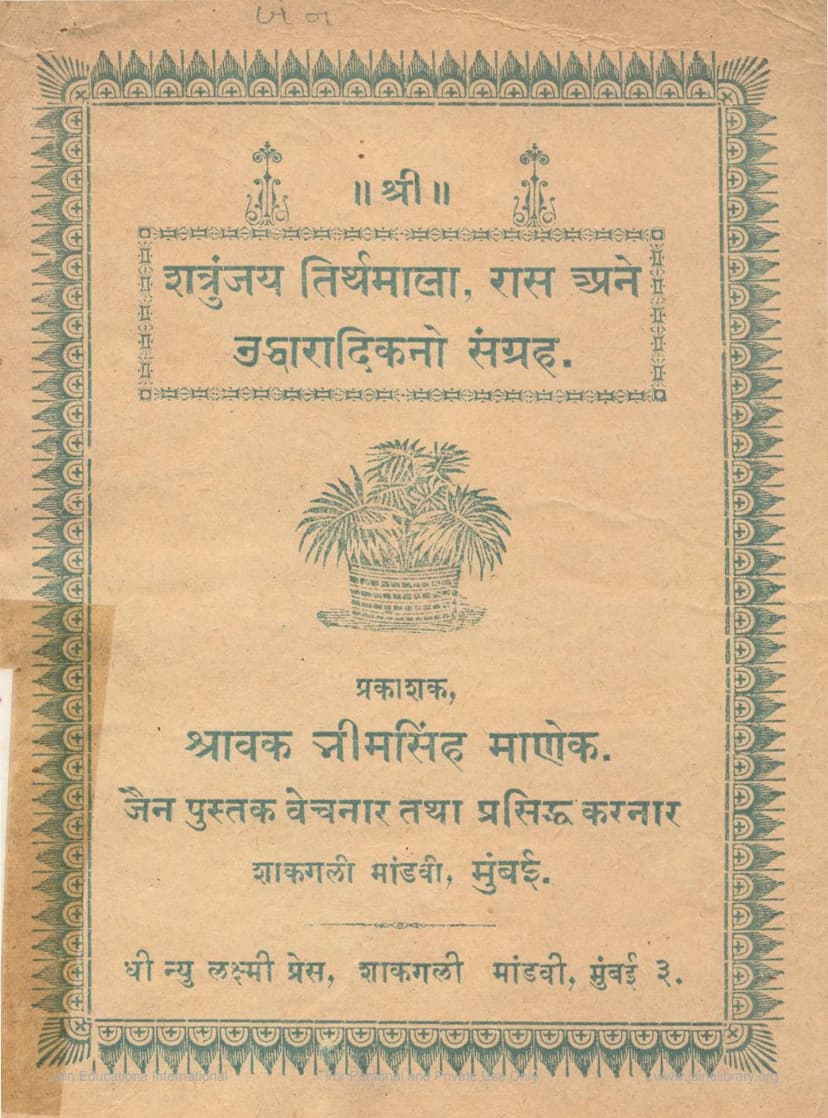Shatrunjay Tirthmala Ras Ane Uddharadikno Sangraha
Added to library: September 2, 2025

Summary
This document is a collection of Jain religious texts, primarily focusing on the pilgrimage to Shatrunjay, also known as Siddhachal or Vimalgiri. It appears to be a compilation of various devotional songs (ras, stavans, dohastuti), historical accounts of renovations (uddhar), and lists of significant sites and events related to the pilgrimage.
Here's a breakdown of the content based on the provided pages:
Book Title: Shatrunjay Tirthmala Ras ane Uddharadikno Sangraha Author/Publisher: Shravak Bhimsinh Manek Publisher Details: Jain book seller and publisher, Shak Galli, Mandvi, Mumbai. Printed at Shri New Laxmi Press.
Key Sections and Content:
-
Page 1-2: Title page and publication details. It indicates that this is the third edition and is intended to be kept by all Jain brothers during Kartik and Chaitri Purnima and while undertaking the Shatrunjay Yatra. The publication year is given as Samvat 1979 (1923 CE).
-
Page 3: Index of Texts (ग्रंथानुक्रमणिका). This is a crucial page listing the various texts included in the collection:
- Shri Siddhachalji no Uddhar (Renovation of Shri Siddhachal) by Nayasundarji.
- Shri Sidhgiri Stuti na Doha (Couplets in praise of Shri Sidhgiri).
- Adinath Vinnati rup Shatrunjay nu Mahotu Stavan (A grand devotional song in praise of Shatrunjay, in the form of a request to Adinath).
- Shri Shatrunjay Tirthmala by Amritvijayji.
- Shatrunjay na Ekveesh Khamsaman Sambandhi Jangan Chalees Doha (Forty couplets related to 21 virtues of Shatrunjay, with a focus on 'Khamsaman') by Virvijayji.
- Vimalkeval Gyan Kamlo Chaityavandan (Praise of Vimalkeval Gyan).
- Siddhachal Shikre Chado, Chaityavandan (Climbing the peak of Siddhachal, a devotional chant).
- Virji Aaya Re Vimalachal Ke Medan, Stavan (A devotional song about Lord Mahavir arriving at Vimalachal).
- Shri Shatrunjay Mangal Jhannajinnd Dayal, Thoy (A devotional song about Shatrunjay, invoking the merciful Jhannajinnd).
- Shri Shatrunjaygiri Tirth Sar, Thoy (The essence of the Shatrunjaygiri pilgrimage).
- Shri Shatrunjay na Ekveesh Nam Hetusahit (21 names of Shatrunjay with their meanings/reasons).
- Shri Shatrunjay no Ras by Samaysundarji.
- Shejo Jo vana ho Jor Je Ji Raj Stavan (A devotional song).
- Shashwat Jin Chaityo na Sthanako (Locations of eternal Jin temples).
- Chovish Jin na Kalyani K na Divas (Dates of auspicious events for the 24 Tirthankaras).
- Dada Mora Sasariye Valavya.
- Najiraya Vanshe Garu Udayo Dinand.
-
Page 4 onwards: The text then proceeds to present the actual devotional songs and narratives.
Key Themes and Narratives:
- Glory of Shatrunjay: The texts consistently praise Shatrunjay as the most sacred pilgrimage site, comparable to celestial beings like Indra in the heavens or the moon among stars. It is described as a place where countless Tirthankaras and liberated souls (Siddhas) have attained salvation.
- Historical Renovations (Uddhar): A significant portion of the text details the various renovations and constructions undertaken at Shatrunjay by kings, emperors, and devout individuals throughout history. The first major renovation is attributed to King Bharat (also referred to as Jaratsen or Jarat) and his family, which involved building magnificent temples and installing idols. Subsequent renovations by various kings, celestial beings (Indra, Brahmendra, etc.), and prominent figures are also mentioned, highlighting the continuous effort to maintain and enhance the sanctity of the pilgrimage.
- The Miraculous Nature of Shatrunjay: The texts describe the transformative power of visiting Shatrunjay. It is said to purify even the most sinful individuals, ward off misfortune, and bestow spiritual merit. Even animals and birds that are associated with the pilgrimage are believed to gain liberation.
- Auspicious Times for Pilgrimage: Chaitri and Kartik Purnimas are highlighted as particularly auspicious times for visiting Shatrunjay.
- Legends and Stories: The texts incorporate stories of Tirthankaras like Rishabhdev (Adinath), Neminath, Shantinath, and Munisuvrat, and their connection to Shatrunjay. The narrative of King Bharat's pilgrimage and the construction of the first temple is a prominent story. The role of figures like Punyapal (Punmarik), Samaysundarji, Amritvijayji, and Virvijayji as composers of devotional works is evident.
- Detailed Descriptions of the Site: The text provides descriptions of various locations within Shatrunjay, including specific temples, idols, rivers (Shatrunji river), trees (Rayani tree), and architectural features. It also lists the names of the Tirthankaras and other significant figures whose idols are present.
- The 21 Names of Shatrunjay: The compilation includes a list of 21 names attributed to Shatrunjay, along with their etymological explanations, further emphasizing its multifaceted significance.
- Calculations of Jain Cosmology: The text briefly touches upon Jain cosmology, mentioning the cycles of time (Utsarpini and Avsarpini) and the varying heights of the mountain during different eras.
- Devotional Practices: The texts encourage various devotional practices such as bathing in the Shatrunji river, offering worship, chanting mantras, performing rituals, and observing fasts.
Overall Purpose:
The "Shatrunjay Tirthmala Ras ane Uddharadikno Sangraha" serves as a comprehensive guide and devotional companion for pilgrims undertaking the journey to Shatrunjay. It aims to:
- Educate: Provide information about the history, legends, and significance of Shatrunjay.
- Inspire: Foster devotion and a deeper connection to the Tirth through various poetic and narrative forms.
- Guide: Offer practical information about the sites and practices during the pilgrimage.
- Preserve: Document and disseminate the rich heritage of Jain devotional literature and historical accounts related to Shatrunjay.
The document is a valuable resource for understanding the spiritual importance and historical continuity of the Shatrunjay pilgrimage within the Jain tradition.